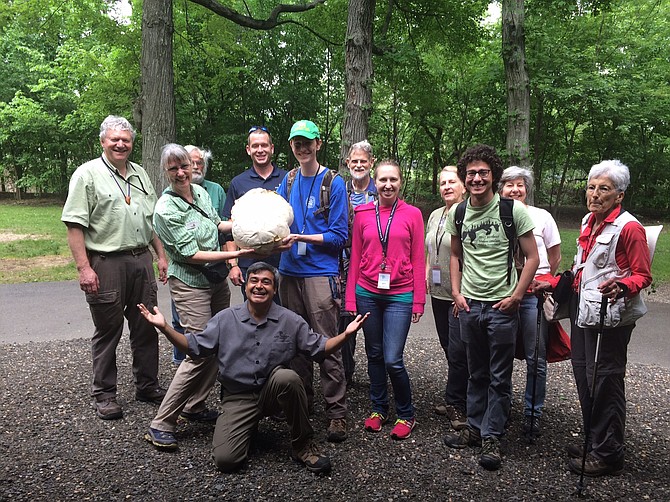Arlington County Natural Resources Manager Alonso Abugattas crouches on the ground while volunteers gather around a fungus that mycologist Rachel Toman and her team discovered, known as a “puffball."
More than 90 citizens and scientific experts flocked to local parks on May 20 to find over 400 species during Arlington County’s first bioblitz. A “bioblitz” is a 24-hour biotic survey of an ecosystem used to evaluate its biodiversity.
The event kicked off at midnight as the Arlington County Department of Parks and Recreation installed eight cameras at Barcroft Park to take snapshots of wildlife. At 10 a.m., most volunteers arrived to the park. Many came from the department’s partner organizations such as The Tree Stewards of Arlington and Alexandria, the Master Gardener program, and the Arlington Regional Master Naturalist (ARMN).
Experts led volunteers to determine the presence or absence of birds, insects, plants, fungi, and other wildlife that the department had identified in a 2009 survey. In addition to searching Barcroft Park, other volunteers perused Glencarlyn Park, Long Branch Nature Center and Park, Gulf Branch Nature Center and Park, Tuckahoe Park, Fort C.F. Smith Park, Bluemont Park, and the Potomac Overlook Regional Park.
Experts and volunteers alike catalogued their discoveries by taking photos and uploading them to the iNaturalist app. Their findings will contribute to Arlington County’s updated Natural Resource Management Plan. Arlington County Natural Resources Manager Alonso Abugattas will also present a report on the bioblitz at the Natural Resources Joint Advisory Group meeting on June 5.
Keeping a record of the presence or absence of each species will help the county to track and protect Arlington’s biodiversity. “If you want to preserve a species, you have to identify it first,” Abugattas said.
Protecting species also entails identifying and removing invasive species. City of Alexandria’s Natural Resources Manager and Plant Ecologist Rod Simmons explained that the nursery industry can introduce invasive species to Arlington’s ecosystems when citizens install invasive plants in their yards and birds spread them through forests.
About five years ago, invasive species such as Multiflora Rose and the Japanese Honeysuckle threatened the biodiversity of Barcroft Park’s ecosystem. However, ARMN volunteers among others removed them. The native Mayapple now thrives. ARMN President Marion Jordan said, “We are proud to play our part protecting natural resources. We realize Arlingtonians can do more collectively than independently.”
Scott Graham, Arlington County’s natural resource technician, continues to combat invasive species by leading Remove Invasive Plants (“RiP”) walks. Citizens may also play their part by learning to identify and remove invasive plants in their yards. Arlington County’s website and the Native Plant Society offer educational resources to citizens.
Despite the pervasive threat of invasive species, discoveries of certain wildlife during the bioblitz reflect the strong health of Arlington’s ecosystems. Simmons and his team found a rare Black-Footed Polypore mushroom.
Warren Steiner, a retired research collaborator at the Smithsonian Institution, identified an Arrhenodes. Steiner, who walked through the forest barefoot and whose skin appears permanently tanned, found the weevil on the bark of a tree.
Both organisms indicate that humans have not irreversibly disturbed Barcroft’s mature forest.
At 4 p.m., the bioblitz culminated in the discovery of a circular, 40 centimeter in diameter fungus, found by mycologist Rachel Toman’s team. Most refer to the Calvatia Gigantea as a “puffball” because it emits smoke when its mature fruit body bursts. “The humongous puffball set an Arlington County record,” Abugattas said.
Teams also discovered species that experts did not record 10 years ago. Such findings include a Montane Woodland Seep, Highbush Blueberry Plant, European Elm Flea Weevil, and a Kissing Bug. Steiner said that although the weevil is non-native, it is too soon to determine if it has a detrimental effect on the park’s ecosystem.
The 24-hour bioblitz jumpstarted the department’s two-year survey of Arlington’s natural resources. Abugattas explained that the bioblitz exemplifies citizen science, in which residents function as the constant eyes and ears of their community’s ecosystems. “Arlingtonians are more than data collectors,” he said, “they preserve the county’s biodiversity.”
